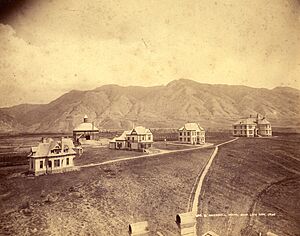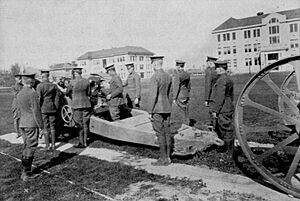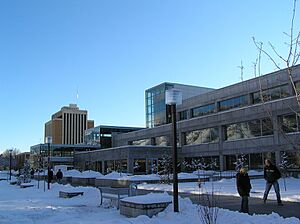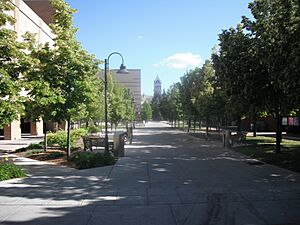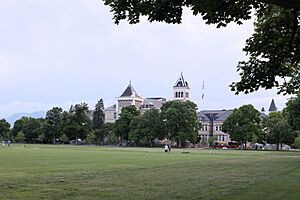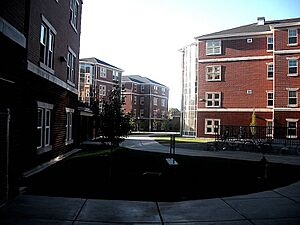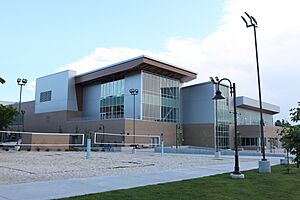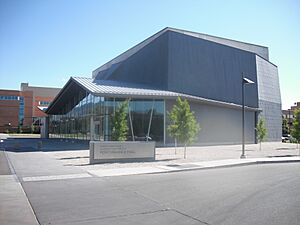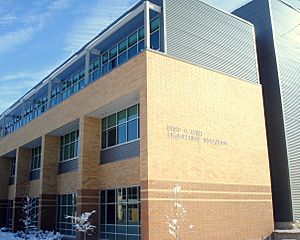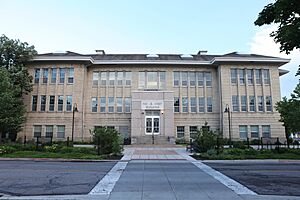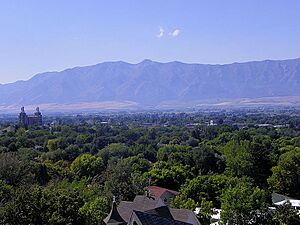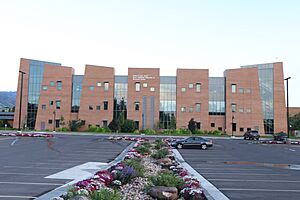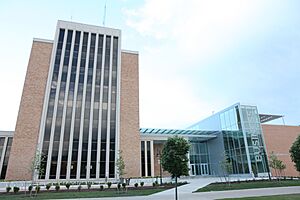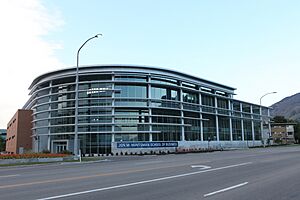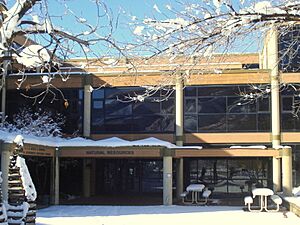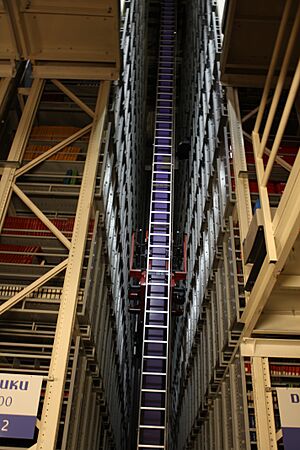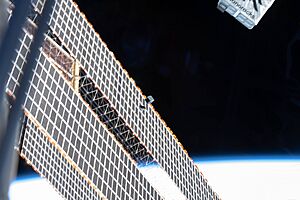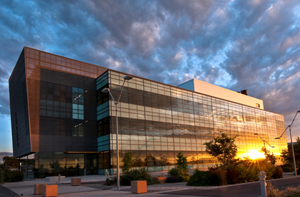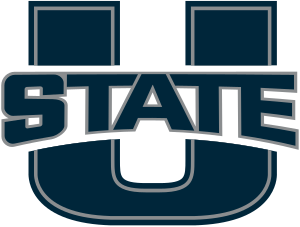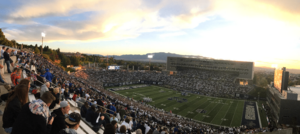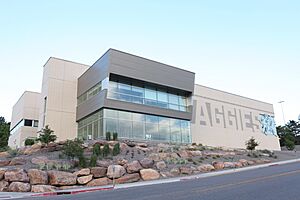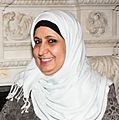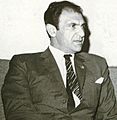Utah State University facts for kids
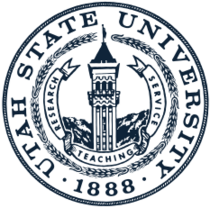 |
|
|
Former names
|
Agricultural College of Utah (1888–1928) Utah State Agricultural College (1928–1957) |
|---|---|
| Motto | "Research, Service, Teaching" |
| Type | Public land-grant research university |
| Established | March 8, 1888 |
|
Parent institution
|
Utah System of Higher Education |
| Accreditation | NWCCU |
|
Academic affiliations
|
|
| Endowment | $614.9 million (2024) |
| Budget | $1.2 billion (FY2024) |
| President | Alan Smith (interim) |
| Provost | Larry Smith |
|
Academic staff
|
1,101 (fall 2023) |
|
Total staff
|
11,077 (fall 2023) |
| Students | 28,900 (fall 2024) |
| Undergraduates | 25,702 (fall 2024) |
| Postgraduates | 3,198 (fall 2024) |
| Location |
,
,
United States
41°44′33″N 111°48′45″W / 41.74250°N 111.81250°W |
| Campus | Small city, 600 acres (2.4 km2) All campuses and centers: 6,896 acres (27.91 km2) |
| Other campus locations | |
| Newspaper | The Utah Statesman |
| Colors | Dark navy and white |
| Nickname | Aggies |
|
Sporting affiliations
|
Pac-12 (starting July 1, 2026) |
| Mascot | Big Blue |
 |
|
Utah State University (often called USU or Utah State) is a large public university in Logan, Utah, USA. It was started in 1888 to teach practical subjects like farming and engineering. USU is known as a "land-grant" university, which means it received land from the government to help people learn useful skills.
Utah State is a top university for research, meaning its professors and students work on many important projects. It's also Utah's biggest public university where students live on campus. More than 84% of students live in dorms or other housing near the school.
In the past, USU's military science program was very strong. It trained many officers for the U.S. military, almost as many as the United States Military Academy at West Point. This earned USU the nickname "West Point of the West."
As of fall 2024, about 28,900 students attend Utah State. The university has many locations across Utah, with 30 campuses and over 50 research centers. One important center is the Space Dynamics Laboratory (SDL). This lab works with the U.S. Department of Defense on space projects. USU, working with SDL, has sent more experiments and equipment into space than any other university in the world!
Utah State is also a leader in research funding. In 2023, it spent over $400 million on research. The university has one of the oldest programs in the U.S. where undergraduate students (those working on their first college degree) can do research. It also has Utah's only colleges for veterinary medicine (animal doctors) and agriculture (farming).
Utah State's sports teams are called the Utah State Aggies. They compete in NCAA Division I, which is the highest level of college sports. They are part of the Mountain West Conference but are set to join the Pac-12 Conference starting July 1, 2026.
Contents
University History
How Utah State Started
In 1862, a law called the Morrill Land-Grant Colleges Act was passed in the U.S. This law helped create colleges in each state that would teach practical skills to everyone, especially those who worked hard.

A leader in Utah, Anthon H. Lund, saw a need for a school that combined science and research with agriculture, which was important to many people in Utah. When he heard about the Morrill Act, he suggested creating such a college. People in Logan, Utah, worked hard to have the college in their city.
So, on March 8, 1888, the Agricultural College of Utah was officially started. On September 2, 1890, a 14-year-old named Vendla Berntson became its very first student.
Early Challenges and Growth
When it first started, Utah State was meant to focus on military science, technology, science, agriculture, and mechanical arts. In its early years, there were talks about combining it with the University of Utah. Some people in Salt Lake City worried that Utah State was growing too much and might take away from the University of Utah.
In 1907, an agreement was made to limit what the Agricultural College could teach. This meant closing some departments, like music, that didn't fit the agriculture and mechanical arts focus. Over the next 20 years, most of these limits were removed. By the 1990s, all restrictions on Utah State's growth were gone.
The college continued to grow. In 1914, it added its statewide Extension program, which shares university research with communities. A year later, it started offering master's degrees. During World War I, many students joined the Student Army Training Corps, where they received military training and could return to their studies afterward. This led to new buildings being built on campus.
After World War I, the military science program became even stronger. By 1947, Utah State was known for training many officers for the U.S. military, second only to West Point. This is why it earned the nickname "West Point of the West." Both USU and Oregon State University share this nickname because of their strong military training programs.
The 1920s and 1930s brought more growth. The school became the Utah State Agricultural College in 1929. In 1957, it officially became Utah State University.
During World War II, Utah State was one of only six colleges chosen by the U.S. Navy for a special Electronics Training Program. Students studied electrical engineering for 14 hours a day! About 2,750 Navy students graduated from this program at Utah State.
In the late 1970s, the university faced challenges related to its international student population. After some time, the number of international students decreased but has recently started to grow again.
By the end of the 20th century, Utah State wanted to be known more widely, not just as a local school. Under President George Emert (1992-2000), the university's special fund for future projects grew from $7 million to $80 million.
Utah State in the 21st Century
In recent years, Utah State has worked with other universities and governments around the world. The Merrill-Cazier Library opened in 2005. In 2010, USU took over the Swaner Preserve and EcoCenter near Park City and the former College of Eastern Utah. In 2012, the university successfully raised $400 million, which was its largest fundraising effort ever.
University System
Utah State University has many campuses and offices across Utah. It also runs several agricultural, animal, plant, and nature centers.
USU's history of teaching students far away goes back to 1904. Professors would travel by train to teach dairy classes. Later, they drove around the state. In 1967, the first official statewide campus was created. By 1996, Utah State used satellite systems to teach students in different locations. Today, the USU system includes USU Eastern and 28 other statewide campuses.
USU Eastern Campus
Located in Price, Utah, the former College of Eastern Utah joined USU in 2010. It became Utah State University Eastern in 2013. USU Eastern offers associate degrees (two-year degrees) and job training programs. Students can also take classes for bachelor's, master's, and doctoral degrees through USU's distance education program. USU Eastern has its own sports teams, the Eastern Utah Golden Eagles.
Statewide Campuses
Utah State has campuses in many cities and towns across Utah. These include Beaver, Brigham City, Salt Lake City, and St. George. Students can earn many different degrees at these locations without having to go to the main Logan campus. Classes and degrees are also available online.
The USU-Moab campus opened on April 1, 2022. The city of Moab helped fund its development. This campus offers degrees that are helpful for the community, like social work. Since it opened, the number of students at USU-Moab has grown.
Cooperative Extension
Started in 1914, the Utah State University Cooperative Extension shares research-based information with communities. It has 30 offices across the state. Extension programs include 4-H (for youth), farming business, healthy eating, gardening, and animal health.
Logan Campus
Utah State University's main campus is in Logan, Utah. It covers 600 acres (about 2.4 square kilometers) at the entrance of Logan Canyon. The campus is on a hill overlooking Cache Valley.
The campus has over 100 buildings. Important places include Maverik Stadium (for football), the Dee Glen Smith Spectrum (for basketball), Old Main (the first building), and the Merrill-Cazier Library.
The Logan City Cemetery divides the campus. The main academic buildings are to the south, and research facilities are to the north. The campus also has dorms, recreation areas, and sports facilities. USU owns more land in Cache County for future growth and research, including farms and research centers.
Recreation and Fitness
Students can use the HPER, Nelson Fieldhouse, and the Aggie Recreation Center (ARC). These places have basketball courts, indoor rock climbing, swimming pools, and outdoor fields for various sports.
Campus Trees and Nature
Utah State's Logan campus is recognized as an arboretum, which is like a living museum of trees. It has over 7,000 trees, including more than 30 of Utah's largest tree types.
Outdoor Fun Near Campus
USU's main campus in Logan is known as a great college town and one of the most beautiful campuses in Utah. It's close to many outdoor places for fun.
Right next to campus are Logan Canyon and the Cache National Forest. Here, students can go hiking, camping, and skiing. Logan Canyon also leads to Beaver Mountain Ski Resort and Bear Lake, which are popular for winter and summer activities like kayaking and fishing. USU's Outdoor Recreation Program helps students by renting equipment and providing maps.
Other cool spots near campus include First Dam, a small reservoir for paddleboarding and fishing. The Logan Country Club, next to campus, is where the university's men's golf team plays.
Students can also visit other ski resorts like Powder Mountain and Cherry Peak. Many students use Utah's YETI ski pass, which gives access to all of Utah's ski resorts. Weekend trips to Yellowstone National Park and Lava Hot Springs are also popular because they are not too far away.
Student Life
| Race and ethnicity | Total | ||
|---|---|---|---|
| White | 82% |
|
|
| Hispanic | 7% |
|
|
| Unknown | 5% |
|
|
| Two or more races | 3% |
|
|
| American Indian/Alaska Native | 1% |
|
|
| Asian | 1% |
|
|
| Black | 1% |
|
|
| International student | 1% |
|
|
| Economic diversity | |||
| Low-income | 32% |
|
|
| Affluent | 68% |
|
|
Living and Eating on Campus
Utah State University is Utah's oldest and largest public university where many students live on campus. About 84% of students live away from home.
There are 21 different buildings for single students and 39 buildings for married students on campus. Many other students live in apartments nearby. Students can eat at two cafeterias, the Forum Cafe in the library, and the Skyroom restaurant. The Hub also offers several dining choices.
On the east side of campus is Aggie Ice Cream, a popular spot that has been making ice cream, cheese, sandwiches, and soups since 1888. Students studying dairy and cooking learned how to make these products. In 1975, the Nutrition and Food Sciences building was built, where Aggie Ice Cream is located today.
USU also has its own chocolate factory, The Aggie Chocolate Factory. It sells chocolate at shops on campus and at sports stadiums. They also sell hot cocoa in winter and a special iced cocoa drink called "Frozen As" when it's hot.
Clubs and Groups
USU students can join over 200 clubs, a student government, seven fraternities, and three sororities. There are also many sports clubs and a student-run radio station.
Campus Fun and Traditions
A well-known tradition is becoming a "True Aggie." This involves kissing someone who is already a True Aggie on top of the Block "A" monument. Two students can also become True Aggies together on Homecoming night or A-Day. In 2011, USU even set a Guinness World Record for the most couples kissing at the same time!
Near the Block "A" is the lighted "A" on top of the Old Main tower. It shines white most nights and turns blue when a USU sports team wins a game or for other special events.
Student Government
The Utah State University Student Association (USUSA) represents all the students. It has 17 elected student officers and five appointed officers. These officers manage campus events, activities, and speak up for students' needs to the state government. Students campaign for these roles each February.
In 2016-2017, the USUSA brought attention to a mental health crisis at Utah State. They worked to raise awareness about long wait times for counseling services and the increasing number of students struggling with mental health. Their efforts led to the Utah State Legislature passing a resolution about mental health at all Utah colleges.
Volunteering and Service
In 1970, USU students created one of the first service organizations in the country. It was called VOICE (Volunteer Organization for Involvement in the Community and Environment). It worked to improve the environment and help with social issues. In 1999, it was renamed The Val R. Christensen Service Center. Today, students are involved in over 20 service groups, like Aggie Special Olympics and Alternative Breaks.
ROTC and Military Traditions
Because of USU's history as a land-grant school, it has strong ROTC (Reserve Officers' Training Corps) programs for the Army, Navy, Coast Guard, and Air Force. ROTC members often serve as the color guard at sports events. They also do pushups and fire a cannon at football games when the Aggies score points! This tradition is especially strong during Veteran's Day and when playing against the U.S. Air Force Academy Falcons.
Big Blue, the Mascot
USU's mascot is Big Blue, a fun and energetic character. Big Blue is usually seen as an athletic performer who dances and does stunts with the Spirit Squad. In the past, Big Blue was a real bull, but now it's a student in a costume.
At home football games, Big Blue leads the Aggie Football team onto the field, riding a Harley-Davidson motorcycle between two pillars of fire! Big Blue is a local celebrity in Logan, often taking pictures and signing autographs with fans and kids. It's a big honor to be chosen as Big Blue, and the student chosen must keep it a secret until a special "de-masking" ceremony.
Music and Celebrations
Utah State has many traditions, including its two fight songs: 'Hail the Utah Aggies' and 'The Scotsman.' 'The Scotsman' is famous for its unified standing and hand motions by students and fans.
Other annual student events include Homecoming and "The Howl," which is the biggest public Halloween party in Utah for USU students. There's also the Luminary Processional to welcome new students and The End of Year Bash concert in April.
University Colleges
| USU's Colleges and Schools | ||||
|---|---|---|---|---|
| College/school | Year founded | |||
| College of Veterinary Medicine | 2022 | |||
| School of Graduate Studies | 1950 | |||
| Caine College of the Arts | 2010 | |||
| College of Agriculture and Applied Sciences | 1888 | |||
| College of Engineering | 1903 | |||
| College of Humanities and Social Sciences | 1888 | |||
| College of Science | 1903 | |||
| Emma Eccles Jones College of Education and Human Services | 1924 | |||
| Jon M. Huntsman School of Business | 1889 | |||
| S.J. & Jessie E. Quinney College of Natural Resources | 1891 | |||
In its early years, USU was divided into different schools, like Agriculture, Military Science, and Home Economics. Over time, it grew and added more areas of study.
Today, USU has ten main academic colleges:
|
|
The College of Veterinary Medicine, Utah's first four-year vet school, was added in 2022. USU's military science and ROTC programs are now part of the College of Humanities and Social Sciences. Aviation and drone programs are in the College of Agriculture and Applied Sciences.
Caine College of the Arts
This college became its own separate college in 2010. It includes departments for Art & Design, Music, and Theatre Arts. It also has the Nora Eccles Harrison Museum of Art, which holds one of the largest art collections in the Intermountain Region. The college has great performance spaces, like the Manon Caine Russell-Kathryn Caine Wanlass Performance Hall, known for its excellent sound.
College of Agriculture and Applied Sciences
This was the first college at USU, started in 1888. It's known for amazing research in animal genetics, human nutrition, and food science. Researchers here helped create the first cloned horses! The college also leads a project to study the sheep genome (their genetic map). It includes departments like Animal, Dairy, and Veterinary Sciences, Aviation Technology, and Nutrition, Dietetics, and Food Sciences.
This college also houses USU's aviation, flight technology, and drone programs at the Logan Airport. In 2013, its name was changed to include "Applied Sciences" to show its wide range of studies.
College of Engineering
The College of Engineering offers degrees in many engineering fields, like biological, civil, computer, electrical, environmental, and mechanical engineering. It also has advanced degrees in aerospace and space systems engineering. Many students in this college work part-time at the Space Dynamics Laboratory (SDL), helping with engineering tasks.
The Utah Water Research Laboratory, part of this college, is the oldest and largest facility of its kind in the U.S. It works on many international projects, especially in dry countries. The college also hosts fun events like an annual pumpkin toss with a trebuchet (a type of catapult).
College of Humanities and Social Sciences
This college teaches many of the basic classes required for all students. It has ten departments and over 30 programs. These include English, History, Journalism, Political Science, and World Languages.
The university is known for studying the American West. It publishes important journals about Western American literature and history. The Department of Journalism and Communication also broadcasts the award-winning A-TV News.
The USU Museum of Anthropology is also located in this college, inside the Old Main building.
Emma Eccles Jones College of Education and Human Services
Founded in 1924, this college has about 5,700 students. It's ranked among the top education schools in the U.S. Its professors do research in areas like child development and health psychology.
USU is the only university in Utah that offers a Housing and Financial Counseling program. This program helps people with debt, budgeting, and home loans through the USU Family Life Center.
Jon M. Huntsman School of Business
In 2007, USU's College of Business became the Jon M. Huntsman School of Business after a large donation from Jon Huntsman Sr.
This is the oldest business college in the Western United States that has been open continuously. It offers degrees in management, accounting, economics, and finance. It also has the only international business degree program at USU.
The Huntsman School of Business also houses the Shingo Institute, which trains leaders around the world. A new business building was completed in 2016, adding classrooms, offices, and new business centers.
S.J. & Jessie E. Quinney College of Natural Resources
This college was renamed in 2012 after a large donation from the S.J. and Jessie E. Quinney Foundation. The Quinneys were USU graduates, and their foundation has supported the college for many years. The college has its own library with collections about natural resources.
Academics
As of fall 2024, Utah State had 28,900 students. The university is approved by the Northwest Commission on Colleges and Universities. USU offers over 270 different degrees, including 137 bachelor's degrees, 95 master's degrees, and 39 doctoral degrees.
There are 19 students for every teacher at USU, and almost half of its classes have fewer than 20 students. USU also offers over 1,000 opportunities to study abroad in 90 different countries.
In 2015, Business Insider called USU the 25th "Most Underrated College" in the United States.
How to Get In
In fall 2022, Utah State received over 16,000 applications from new high school students. About 93.7% of these students were accepted. Of those accepted, about 30.7% chose to enroll at USU. About 74.5% of freshmen continue their studies after their first year, and 52.5% graduate within six years.
| Admissions statistics | |
|---|---|
|
2022 entering
classChange vs. 2017 |
|
| Admit rate | 93.7%
(
|
| Yield rate | 30.7%
(
|
| Test scores middle 50%* | |
| SAT Total | 1070–1300 (among 13.6% of FTFs) |
| SAT EBRW | 530–660 |
| SAT Math | 520–660 |
| ACT Composite | 20–27 (among 80.0% of FTFs) |
| High school GPA† | |
| Top 10% | 22.8%
(
|
| Top 25% | 46.1%
(
|
| Top 50% | 75.6%
(
|
| Average | 3.61
(
|
|
|
University Rankings
| ARWU World | 401–500 |
|---|---|
| USNWR National University | 259 (tie) |
| Washington Monthly National University | 54 |
| Business | Unranked |
| Education | 39 (tie) |
| Engineering | 111 (tie) |
| Audiology | 30 (tie) |
| Biological Sciences | 119 (tie) |
| Chemistry | 119 (tie) |
| Computer Science | 120 (tie) |
| Earth Sciences | 113 (tie) |
| Economics | 110 (tie) |
| English | 122 (tie) |
| Fine Arts | 158 (tie) |
| Mathematics | 117 (tie) |
| Physics | 163 (tie) |
| Psychology | 162 (tie) |
| Public Health | 193 (tie) |
| Rehabilitation Counseling | 6 (tie) |
| Social Work | 120 (tie) |
| Sociology | 106 (tie) |
| Speech-Language Pathology | 52 (tie) |
| Statistics | 79 (tie) |
In 2021, Utah State was recognized as a national leader for its undergraduate research programs. In 2024, Washington Monthly ranked Utah State 54th among national universities and 8th best public university in the U.S. for its public good contributions.
Also in 2024, U.S. News & World Report ranked USU 32nd in the nation for its "Best Online Bachelor's Programs." Forbes ranked the university highly in 2023 for public colleges and research universities.
Research at USU

Utah State University is known for "Very high research activity." In 2022, it spent $344.9 million on research and development.
USU has over 50 research centers. Some important ones include the Space Dynamics Laboratory, the Utah Water Research Laboratory, and the Swaner Preserve and EcoCenter.
As of 2010, Utah State University has sent more student experiments into space than any other school in the world.
In 2024, Utah State joined the United States Space Command Academic Engagement Enterprise, showing its strong connection to space research.
Space Dynamics Laboratory
The Space Dynamics Laboratory (SDL) is a special research center owned by Utah State. It's one of only 15 such centers that work with the United States Department of Defense. SDL has completed over 430 successful space missions and developed more than 500 hardware and software systems.
Some of SDL's projects include:
- WISE
- SABER
- SOFIE
- ICON
- OSIRIS-REx
In 2021, Utah State received a huge $1 billion contract for aerospace research from the Air Force Research Laboratory. This was the largest contract ever given by that lab.
Working with SDL, Utah State has sent more experiments into space than any other university in the world.
GASPACS Space Project
GASPACS (Get Away Special Passive Attitude Control Satellite) was a small satellite project sponsored by NASA. It was built entirely by undergraduate students at Utah State University. Its main goal was to deploy an inflatable boom to help stabilize its position in space. GASPACS was the first small satellite (CubeSat) built entirely by undergraduate students and the first to use a Raspberry Pi Zero as its computer.
USTAR Research
Utah State is a key part of the Utah Science Technology and Research (USTAR) program. This program helps Utah's high-tech economy by focusing on the state's strengths. Eight USTAR research teams work at Utah State on projects like:
| USTAR research teams | Description of research and markets |
|---|---|
| Arrhythmia Consortium | Studying heart rhythm problems and heart disease. |
| Applied Nutrition | Researching obesity, heart problems, diabetes, and Alzheimer's. |
| Intuituive Building | Creating smart lighting solutions for buildings. |
| Synthetic Bio-Manufacturing | Developing new ways to make medicines, fuels, and plastics. |
| STORM | Working on better weather prediction. |
| Veterinary Diagnostics and Infectious Disease(VDID) | Finding ways to diagnose and treat animal diseases. |
| Space Weather | Studying how space weather affects telecommunications and aviation. |
| Wireless Power Transfer | Developing ways to transfer energy and power without wires. |
Student Research
USU's undergraduate research program started in 1975, making it the second oldest in the nation. In 2021, it was named the "Best Undergraduate Research Program in the Nation."
Animal and Veterinary Science
Since 2022, Utah State has been home to Utah's only college for veterinary medicine.
A team of USU and University of Idaho researchers were the first in the world to successfully clone a horse. The baby mule, named Idaho Gem, was born in 2003.
USU researchers also made news in 2011 for creating "spider goats." These goats produce milk that contains spider silk, which is being studied for uses like human muscle tissue and lightweight bulletproof vests.
Research Farms
Utah State owns and runs 14 different research farms. It also has several centers for animals, agriculture, nature, and plants across the state.
Swaner Preserve and EcoCenter
In 2010, Utah State took over the Swaner Preserve and EcoCenter near Park City. This center includes a 1,200-acre (about 4.8 square kilometers) nature preserve and a 10,000-square-foot (about 929 square meters) building for environmental education. The preserve protects important wetlands, and the EcoCenter is a very eco-friendly building.
Athletics
Utah State University has many sports teams, including varsity, club, and intramural sports. Since 1888, USU's teams and athletes have won six individual national championships.
Varsity Sports Teams
USU has 16 official varsity sports teams, known as the Utah State Aggies. They compete in NCAA Division I as part of the Mountain West Conference (MWC), which they joined in 2013. The university's teams have won 37 conference championships, including three national championships (one in Women's Volleyball and two in Softball).
Utah State Aggies has 16 NCAA Division I teams, including:
|
|
|
The men's basketball team plays in the Dee Glen Smith Spectrum. This arena has been called one of the "15 Toughest Places To Play In College Basketball." ESPN has also said that USU's student cheering section, The HURD, is one of the smartest in the nation. The men's basketball team has been very successful, winning many games and making it to the NCAA Tournament several times.
USU's football team is part of the Division I Football Bowl Subdivision (FBS). The football program has improved a lot in recent years, winning its first conference championship in 2012. The Aggies were members of the WAC (Western Athletic Conference) from 2005 to 2012, winning many championships in different sports during that time.
As members of the Mountain West Conference, the Aggies have continued to win championships in football, men's tennis, men's cross country, and women's volleyball.
Club Sports
Utah State University's club sports teams have also had national success, winning 15 national titles. The baseball club has won two national championships. The rodeo club has two individual national champions. The handball club has won nine national titles, and the Cycling Club has two individual national championships.
USU's Logan Campus offers many competitive club sports for students, including:
|
|
|
Intramural Sports
Intramural sports are offered for students, teachers, and staff. These are fun, less competitive sports leagues played on campus.
Media
Utah State University publishes several journals, including Utah Science and Western Historical Quarterly. The Utah State University Press publishes books on topics like folklore, history, and nature.
The Utah Statesman is the main newspaper for Utah State students. It's run by students with a faculty advisor. The paper is published once a week and is free. It has won awards for its writing.
Aggie Radio 92.3 KBLU-LP is a radio station run entirely by students. It plays local, alternative, and independent music for students and the community. It also broadcasts all Utah State University football and basketball games.
Utah Public Radio is a radio service from Utah State University. It broadcasts news, information, and cultural programs 24/7 across Utah and Southern Idaho. It is connected with National Public Radio.
Aggie TV is a cable TV service with about 110 channels, offered free to students living on campus. It also has channels with campus announcements and student video programs.
Famous People from USU
USU has been home to many famous people. These include seven Rhodes Scholars (students who get to study at Oxford University in England), one Nobel Prize winner, and many astronauts, like Mary L. Cleave.
Many political leaders have attended USU, including Spencer Cox, the current governor of Utah, and Hesham Qandil, a former Prime Minister of Egypt. USU alumni also include artists, athletes, and leaders of major companies.
| Rich Etchberger | Wildland Resources | 2015 |
| Joyce Kinkead | English | 2013 |
| Michael Christiansen | Music | 2012 |
| Jim Cangelosi | Mathematics and Statistics | 2011 |
| Laurie McNeill | Civil and Environmental Engineering | 2010 |
| David Peak | Physics | 2009 |
| Lyle McNeal | Animal, Dairy and Veterinary sciences | 2007 |
| Bonnie Glass-Coffin | Anthropology | 2004 |
| Jan Sojka | Physics | 2002 |
| David F. Lancy | Anthropology | 2001 |
| Mark Damen | History, Classics, Theatre | 1998 |
| Sonia Manuel-Dupont | Education, English, Engineering | 1997 |
| Ted Alsop | Geography | 1996 |
| Frances Titchener | History, Classics | 1995 |
The Alumni Association, for former students, was created in 1899. Today, it's in the David B. Haight Alumni Center. USU has 149,000 alumni living in all U.S. states and over 110 countries.
Some especially famous alumni include:
- Harry Reid, former U.S. Senator and Senate Majority Leader.
- Lars Peter Hansen, a Nobel Prize winner in Economics.
- Merlin Olsen, a professional football Hall-of-Famer and actor.
- Bobby Wagner, an NFL linebacker.
- Cha Joo-Young, a South Korean actress.
- Julie A. Robinson, former Chief Scientist of the International Space Station.
Famous faculty members have included:
- Stephen R. Covey, author of The Seven Habits of Highly Effective People.
- Don L. Lind, a NASA astronaut.
- George Dewey Clyde, a former Governor of Utah.
Images for kids
-
Mary L. Cleave, M.S. 1975, Ph.D. 1980, Space Shuttle astronaut.
-
Spencer Cox, American attorney and politician serving as the 18th and current Governor of Utah since 2021.
-
Lars Peter Hansen, B.S. 1974, Nobel Laureate Economist.
-
Harry Reid, B.S. 1961, U.S. Senator and Senate Majority Leader 2007–2015, D-NV.
-
Hesham Qandil, M.S. 1988, Prime Minister of Egypt.
See also
 In Spanish: Universidad Estatal de Utah para niños
In Spanish: Universidad Estatal de Utah para niños



